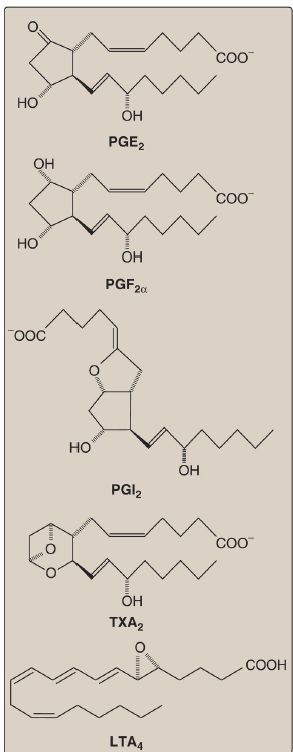


 النبات
النبات
 الحيوان
الحيوان
 الأحياء المجهرية
الأحياء المجهرية
 علم الأمراض
علم الأمراض
 التقانة الإحيائية
التقانة الإحيائية
 التقنية الحيوية المكروبية
التقنية الحيوية المكروبية
 التقنية الحياتية النانوية
التقنية الحياتية النانوية
 علم الأجنة
علم الأجنة
 الأحياء الجزيئي
الأحياء الجزيئي
 علم وظائف الأعضاء
علم وظائف الأعضاء
 الغدد
الغدد
 المضادات الحيوية
المضادات الحيوية|
Read More
Date: 6-12-2021
Date: 6-10-2021
Date: 26-8-2021
|
Eicosanoids: Prostaglandins ,Thromboxanes , and Leukotrienes
Prostaglandins (PG), thromboxanes (TX), and leukotrienes (LT) are collectively known as eicosanoids to reflect their origin from ω-3 and ω-6 polyunsaturated FA with 20 carbons (eicosa = 20). They are extremely potent compounds that elicit a wide range of responses, both physiologic (inflammatory response) and pathologic (hypersensitivity). They insure gastric integrity and renal function, regulate smooth muscle contraction (the intestine and uterus are key sites) and blood vessel diameter, and maintain platelet homeostasis. Although they have been compared to hormones in terms of their actions, eicosanoids differ from endocrine hormones in that they are produced in very small amounts in almost all tissues rather than in specialized glands and act locally rather than after transport in the blood to distant sites.
Eicosanoids are not stored, and they have an extremely short half-life, being rapidly metabolized to inactive products. Their biologic actions are mediated by plasma membrane GPCR , which are different in different organ systems and typically result in changes in cyclic adenosine monophosphate production. Examples of eicosanoid structures are shown in Figure 1.

Figure 1: Examples of eicosanoid structures. [Note: Prostaglandins are named as follows: PG plus a third letter (for example, E), which designates the type and arrangement of functional groups in the molecule. The subscript number indicates the number of double bonds in the molecule. PGI2 is also known as prostacyclin. Thromboxanes are designated by TX and leukotrienes by LT.]



|
|
|
|
"عادة ليلية" قد تكون المفتاح للوقاية من الخرف
|
|
|
|
|
|
|
ممتص الصدمات: طريقة عمله وأهميته وأبرز علامات تلفه
|
|
|
|
|
|
|
ضمن أسبوع الإرشاد النفسي.. جامعة العميد تُقيم أنشطةً ثقافية وتطويرية لطلبتها
|
|
|